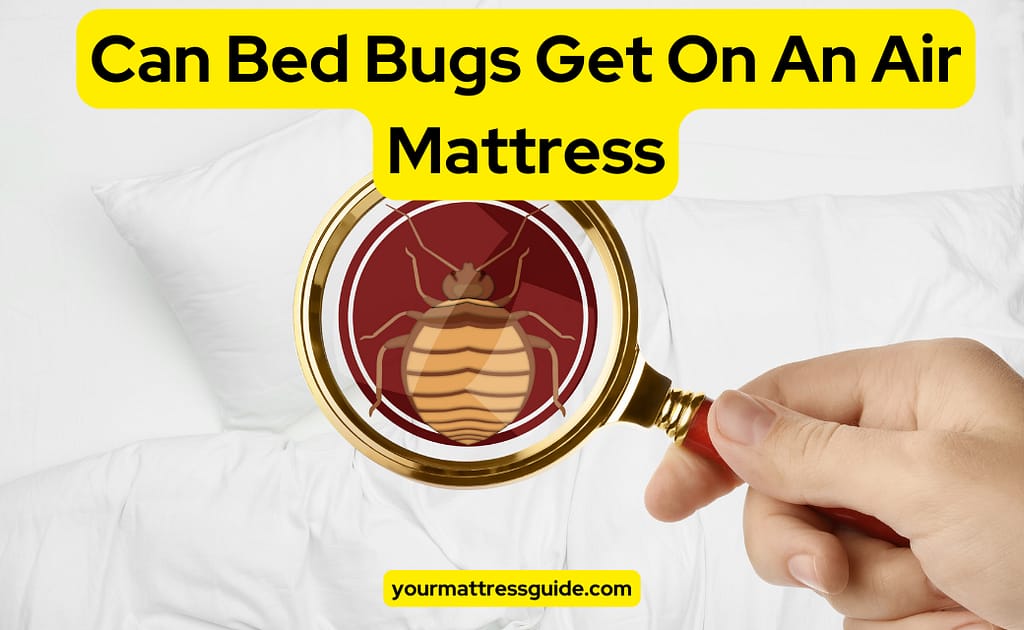Ah, the humble air mattress. Friend of camping trips, sleepovers, and unexpected guests. But lurking in the shadows of its inflatable comfort could be an unwelcome visitor: the notorious bed bug. And if you think can bed bugs get on an air mattress, then you might be right!
These blood-sucking hitchhikers are notorious for infesting homes and wreaking havoc on sleep schedules. So, can these tiny terrors infiltrate your air mattress, turning your sweet dreams into itchy nightmares?

Can bed bugs get on an air mattress Understanding Bed Bugs
The tiny, reddish-brown bed bugs (Cimex lectularius) feed on the blood of both people and animals. They are infamous for their capacity to spend the day hiding in nooks and crannies and then coming out at night to dine on their unsuspecting hosts. Bed bugs are great hitchhikers and can go from place to place by attaching themselves to garments, bags, or other personal belongings.
How Do Bed Bugs Infest Mattresses?
In the past, outbreaks in wooden bed frames, pillows, and other bedroom furnishings were linked to bed bug infestations. The bedroom is a perfect hiding place for these bugs since they want to remain close to their hosts. Because of its tufts, seams, and folds, mattresses give bed bugs many of places to hide. Curious about the benefits of mattress pads? Learn what is a mattress pad and how it can enhance your sleep experience.
Air Mattresses: Are They More Prone To Getting Bed Buga?
When it comes to preventing bed bugs, air mattresses offer a clear edge over ordinary mattresses. Most air mattresses have a smooth, impervious surface that makes it difficult for bed bugs to locate good hiding places. Air mattresses don’t provide the dark, protected places that bed bugs love, unlike the joints and folds of a regular mattress.
Air mattresses are less likely than ordinary mattresses to become infested with bed bugs, but it’s still possible. Because they are opportunistic insects, bed bugs can still manage to get into your air mattress if given the chance. Here are some situations to think about:
Contaminated Surroundings:
If your air mattress comes into contact with infested bedding, clothing, or furniture, there is a risk of bed bugs transferring onto the mattress. This can happen during travel or if the air mattress is stored in an area where bed bugs are present.
Shared Spaces:
If you’re using your air mattress in shared spaces, such as dormitories, hostels, or crowded camping sites, the risk of bed bugs increases. The more people and personal items present, the higher the likelihood of encountering bed bugs.
Storage Concerns:
When not in use, air mattresses are often folded and stored. If the storage area is infested with bed bugs, they may find their way onto the air mattress.
Steps To Prevent Unwanted Bed Bugs
While the risk of bed bugs infesting air mattresses is relatively low, it’s essential to take preventive measures to ensure your sleeping space remains bug-free. Here are some practical steps you can take:
1- Inspect Your Surroundings:
Before setting up your air mattress, inspect the area for any signs of bed bugs. Check seams, folds, and cracks in furniture. If you’re using the mattress in a shared space, be vigilant about the cleanliness and hygiene of the surroundings.
2- Use a Mattress Protector:
Consider using a mattress protector designed to encase the entire air mattress. This can add an extra layer of protection, making it more challenging for bed bugs to access the surface.
3- Choose Your Sleeping Location Wisely:
Opt for well-maintained and clean sleeping environments. Avoid placing your air mattress directly on the floor, especially in unfamiliar or potentially infested areas.
4- Inspect and Clean Your Air Mattress Regularly:
Before and after each use, inspect your air mattress for any signs of bed bugs. Clean the surface with a damp cloth, paying attention to seams and creases. Proper maintenance reduces the likelihood of bed bugs finding a suitable habitat.
5- Practice Safe Travel:
If you’re using an air mattress during travel, be cautious about the places you visit and the items you come into contact with. Avoid placing the mattress on questionable surfaces, and inspect your luggage regularly.
6- Store Your Air Mattress Properly:
When not in use, store your air mattress in a clean and dry environment. Ensure the storage area is free from bed bugs and other pests. Consider using protective covers or bags for added security.

How To Know If Your Air Mattress Has Bed Bugs?
Despite your best efforts, it’s still possible to encounter bed bugs. Knowing how to recognise the signs of an infestation is crucial for swift action. Common signs of bed bugs include:
- Reddish-Brown Stains:
Bed bugs leave behind minor, reddish-brown stains on bedding or mattresses. These stains are a result of their fecal matter and can be an indication of their presence.
- Tiny, Rust-Colored Bugs:
Adult bed bugs are approximately the size of an apple seed and have a reddish-brown color. They are flat and oval-shaped. Spotting these insects on your mattress is a clear sign of an infestation.
- Clustered Bites:
Bed bug bites often appear in clusters or a line on exposed skin. While not everyone reacts to bed bug bites, some individuals may experience redness, itching, or swelling.
- Musty Odor:
In severe infestations, bed bugs release a musty odor. If you notice an unusual smell in your sleeping area, it could be a sign of a significant bed bug problem.
How To Respond to Bed Bug Infestations
If you suspect a bed bug infestation on your air mattress or in your living space, it’s crucial to take immediate action. Here are steps you can take:
- Isolate the Mattress:
If you identify bed bugs on your air mattress, isolate it immediately. Remove all bedding and vacuum the area thoroughly. Seal the mattress in a plastic bag to prevent the bugs from spreading.
- Wash and Clean:
Launder all bedding, clothing, and fabric items that may have come into contact with bed bugs. Use hot water and high heat settings to eliminate these pests effectively.
- Consult Professionals:
While DIY methods can help manage small infestations, significant bed bug problems may require professional intervention. Pest control experts can assess the extent of the infestation and provide effective treatment options.
- Monitor and Prevent Reinfestation:
After addressing the infestation, monitor your living space regularly for signs of bed bugs. Implement preventive measures to avoid future infestations, such as regularly cleaning and inspecting your sleeping area.
Final Words
While the thought of bed bugs can be unsettling, it’s essential to approach the issue with a practical mindset. Air mattresses, with their smooth surfaces, are less prone to bed bug infestations compared to traditional mattresses. However, can bed bugs get on an air mattress? Yes, but the chances are way less than you think.
By following preventive measures, practicing good hygiene, and promptly addressing any signs of infestation, you can enjoy the convenience of your air mattress without the worry of unwanted nocturnal visitors.
Remember, vigilance is key. Planning an outdoor adventure with your air mattress? Discover insights on what size tent for queen air mattress to ensure a comfortable camping experience.
FAQs
Can bed bugs get on an air mattress Can they travel by air?
Although the likelihood of acquiring bed bugs while traveling is minimal, it is crucial to adopt basic preventive measures since infestations spread globally. Clothing and luggage can carry bed bugs, particularly in locations where travelers sleep. Rarely are they seen in automobiles, trains, or aircraft.
What surfaces do bed bugs avoid?
Bed bugs dislike staying on smooth plastic surfaces or climbing them. So, you can cover your mattress in a plastic wrap to avoid bed bug infestation.
How do I make sure I don’t get bed bugs?
Cut down on clutter in your house to lessen bed bugs’ hiding areas. To get rid of any successful hitchhikers, vacuum often. When using communal laundry facilities, exercise caution. Use plastic bags to carry the things you want to wash.


